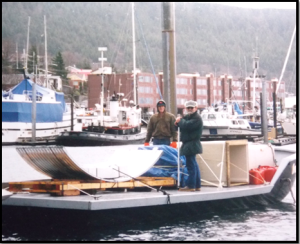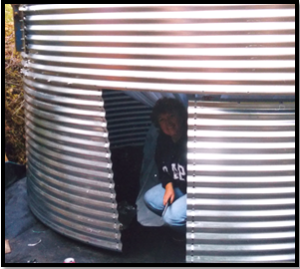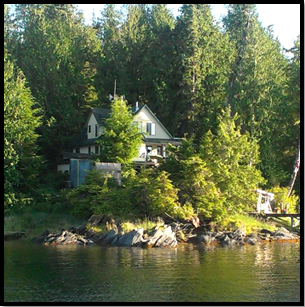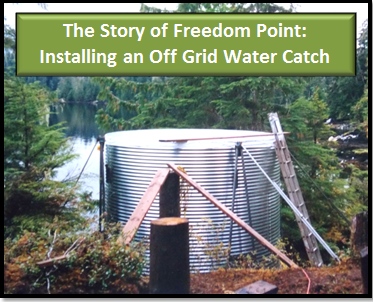Here in rural Southeast Alaska, most people who live outside city limits have water catch systems. They are extremely common and when it comes to living off the grid, are absolutely necessary. Drilling a well isn’t really an option here.
Our friends over at Freedom Point share the story of getting a water catch system not only brought to their remote location by boat, but also some of the installment process. When things don’t work out quite the way you planned or something unexpected happens, being able to adapt goes a long way. Though I grew up here, I learned a lot regarding what it will involve when we go to set our own system up someday. I look forward to not having a water bill like Ed and Linda!
The island community of Ketchikan has never been able develop dependable water wells. The city obtains its water from a nearby lake and has to purify it and re-purify it. Everyone outside the city uses a cistern to store rain water which is directed by gutter systems from the roof of a home or other building. Most cisterns are above-ground tanks of varying sizes from a few hundred gallons up to 10,000 gallons.
The success of these catchment systems becomes obvious when one drives around the roads outside the city and notices the many large tanks next to the homes. Wells have been explored in past years, but with no real success at finding any reliable underground sources of potable water.
 FREEDOM POINT is no exception. We purchased a bolt-together water tank that came in large sections and fit together to form a diameter of about 12 feet. This tank type was selected so we could transport it on our small homemade barge and be able to handle it in sections once on our property. The tank is designed to be assembled with the top ring being the first to bolt together, and then it must be raised by three cable winches to allow the next ring to be assembled and bolted to the bottom of the first, and so on.
FREEDOM POINT is no exception. We purchased a bolt-together water tank that came in large sections and fit together to form a diameter of about 12 feet. This tank type was selected so we could transport it on our small homemade barge and be able to handle it in sections once on our property. The tank is designed to be assembled with the top ring being the first to bolt together, and then it must be raised by three cable winches to allow the next ring to be assembled and bolted to the bottom of the first, and so on.
Our tank has three such sections and holds around 9000 gallons of water. It is lined with a heavy vinyl liner with the top of the liner fastened to the top ring of the tank. The water is picked up at the edge of the roof in a continuous aluminum gutter and directed to a pipe that empties into the top of the tank. We have a pretty large roof surface and with the amount of storage, we have never been out of water in over 15 years of living here.
After determining that we had enough drop from the roof to the top of the new tank, we built a large platform of heavy treated timbers, supported by treated posts which were dug into the ground to bedrock. Then early one morning, we began assembling the rings. Linda got the inside job of holding the bolt heads with a special wrench while I used an electric impact wrench on the outside to install the lock nuts. Lots of bolts.
 Since the vinyl liner is secured to the top ring and raised with the completed portion of tank, it meant that Linda had to work inside the tank between the hanging liner and the metal rings… Certainly not a job for the claustrophobic, plus the impact wrench is very loud inside the tank. Well, we’re a team and by the end of the day, (almost dark) we installed the last section into the bottom ring of the tank, successfully trapping Linda inside between the liner and the tank….Outside, I suddenly [realized] that the cable tripods that we used to raise the [sections of the tank] were not long enough to raise it enough to allow Linda to slip under…..Now what??
Since the vinyl liner is secured to the top ring and raised with the completed portion of tank, it meant that Linda had to work inside the tank between the hanging liner and the metal rings… Certainly not a job for the claustrophobic, plus the impact wrench is very loud inside the tank. Well, we’re a team and by the end of the day, (almost dark) we installed the last section into the bottom ring of the tank, successfully trapping Linda inside between the liner and the tank….Outside, I suddenly [realized] that the cable tripods that we used to raise the [sections of the tank] were not long enough to raise it enough to allow Linda to slip under…..Now what??
After both of us calming a little, I decided to let the two cables on one side down and hold the third as high as possible, place some heavy timber to secure it from coming down, then with a large leverage, I raised that small portion just enough for her to slip under and to freedom. The whole day it had been raining and she had laughed that she was dry under the liner and I was getting soaked. When I threatened to leave her there until tomorrow, she became much more understanding….Thankfully; the tank is up, solid, and the liner in place.
I had installed a fitting in the center of the liner and through the bottom of the timbers to connect a supply pipe running into the house, decided to build a shed roof over the tank to collect water from until the house was completed and we had one more project behind us…water.
Good clean rain water fresh from the clear Alaskan sky…no minerals, no pollutants. We installed a double filtering system inside the house and change the filters about once a month. In the summer months, we add a couple cups of Clorox bleach on the same schedule. We are very happy with the quality of water and the never-ending supply of good Southeast Alaskan rainfall.





